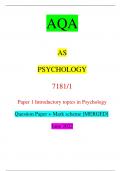Examen
Clinical Nursing Skills and Techniques 11th Edition by by Anne G. Perry , Patricia A. Potter , Wendy R. Ostendorf, Nancy Laplante ISBN- 978-0443107184 Test Bank Verified 2024 Practice Questions and 100% Correct Answers with Explanations for Exam Preparati
Clinical Nursing Skills and Techniques 11th Edition by by Anne G. Perry , Patricia A. Potter , Wendy R. Ostendorf, Nancy Laplante ISBN- 978-0443107184 Test Bank Verified 2024 Practice Questions and 100% Correct Answers with Explanations for Exam Preparation, Graded A+ Clinical Nursing Skills and ...
[Montrer plus]













